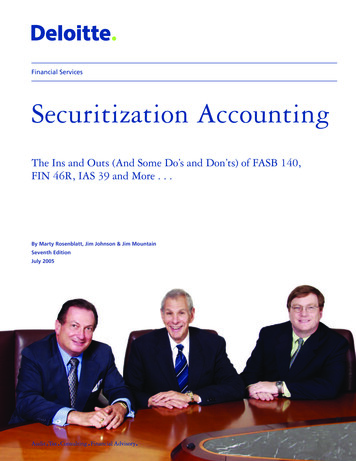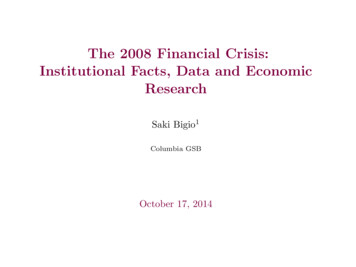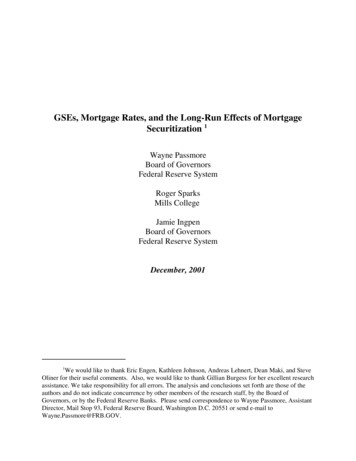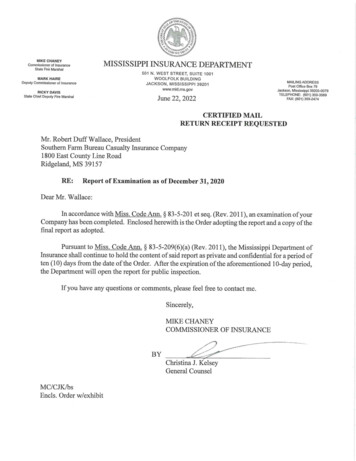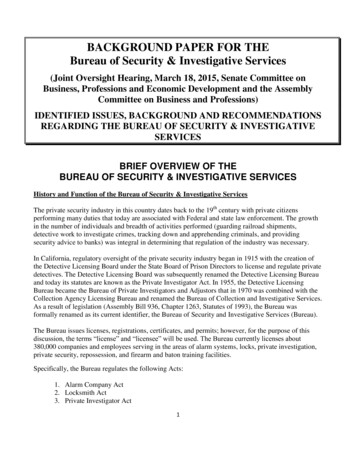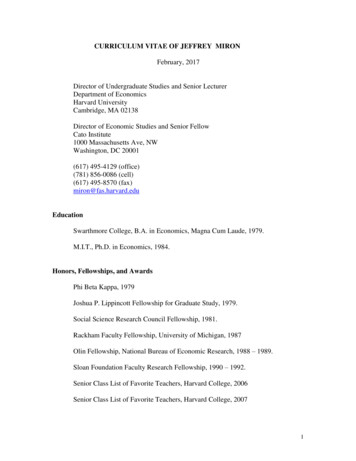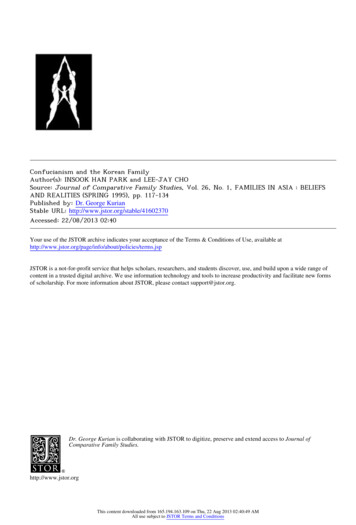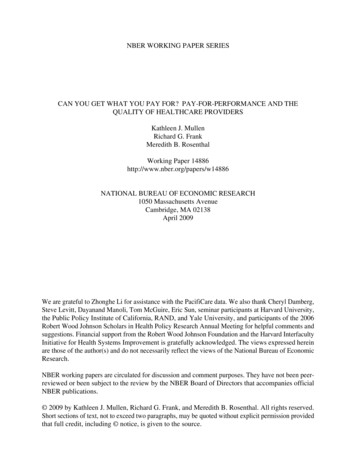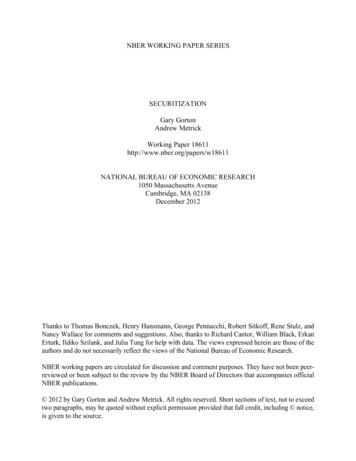
Transcription
NBER WORKING PAPER SERIESSECURITIZATIONGary GortonAndrew MetrickWorking Paper 18611http://www.nber.org/papers/w18611NATIONAL BUREAU OF ECONOMIC RESEARCH1050 Massachusetts AvenueCambridge, MA 02138December 2012Thanks to Thomas Bonczek, Henry Hansmann, George Pennacchi, Robert Sitkoff, Rene Stulz, andNancy Wallace for comments and suggestions. Also, thanks to Richard Cantor, William Black, ErkanErturk, Ildiko Szilank, and Julia Tung for help with data. The views expressed herein are those of theauthors and do not necessarily reflect the views of the National Bureau of Economic Research.NBER working papers are circulated for discussion and comment purposes. They have not been peerreviewed or been subject to the review by the NBER Board of Directors that accompanies officialNBER publications. 2012 by Gary Gorton and Andrew Metrick. All rights reserved. Short sections of text, not to exceedtwo paragraphs, may be quoted without explicit permission provided that full credit, including notice,is given to the source.
SecuritizationGary Gorton and Andrew MetrickNBER Working Paper No. 18611December 2012JEL No. E0,G0,G2ABSTRACTWe survey the literature on securitization and lay out a research program for its open questions. Securitizationis the process by which loans, previously held to maturity on the balance sheets of financial intermediaries,are sold in capital markets. Securitization has grown from a small amount in 1990 to a pre-crisis issuanceamount that makes it one of the largest capital markets. In 2005 the amount of non-mortgage asset-backedsecurities issued in U.S. capital markets exceeded the amount of U.S. corporate debt issued, and thesesecuritized bonds – even those unrelated to subprime mortgages -- were at center of the recent financialcrisis. Nevertheless, despite the transformative effect of securitization on financial intermediation,the literature is still relatively small and many fundamental questions remain open.Gary GortonYale School of Management135 Prospect StreetP.O. Box 208200New Haven, CT 06520-8200and NBERGary.Gorton@yale.eduAndrew MetrickYale School of Management135 Prospect StreetP.O. Box 208200New Haven, CT 06520and NBERmetrick@yale.edu
11. IntroductionPrior to the financial crisis of 2007-2008, securitization was a very large part of U.S. capitalmarkets. It played a central role in the recent financial crisis. Yet it is largely unregulated and itis not well understood. There is little research on this topic. In this paper, we survey theliterature on securitization and summarize the outstanding questions.Traditionally, financial intermediaries originated loans that they then held on their balance sheetsuntil maturity. This is no longer the case. Starting around 1990 pools of loans began to be soldin capital markets, by selling securities linked to pools of loans held by legal entities called“special purpose vehicles” (SPVs). These securities, known as asset-backed securities (ABS) (ormortgage-backed securities (MBS), in the case where the loans are mortgages) are claims to thecash flows from the pool of loans held by the SPV. Such securities can be issued with differentseniorities, known as tranches. Securitization has fundamentally altered capital markets, thefunctioning of financial intermediation, and challenges many theories of the role of financialintermediaries.Securitization has an important role in the U.S. economy. As of April 2011, there was 11trillion of outstanding securitized assets, including residential mortgage-backed securities(RMBS), other ABS and asset-backed commercial paper (ABCP). This is substantially more thanthe size of all outstanding marketable U.S. Treasury securities—bonds, bills, notes, and TIPScombined.1 A large fraction of consumer credit in the U.S. is financed via securitization. It isestimated that securitization has funded between 30 percent and 75 percent of lending in variousconsumer lending markets and about 64 percent of outstanding home mortgages.2 In total,securitization has provided over 25% of outstanding U.S. consumer credit.3Figure 1 shows the U.S. issuance amounts of private securitization and corporate bonds. In 2002the amounts of securitized bonds issued ( 662.4 billion) exceeded corporate bond issuance( 636.7 billion) for the first time, and continued to be larger until the financial crisis. Figure 11U.S. Department of the Treasury, “Monthly Statement of the Public Debt of the United States: January 31, 2011,”(January 2011). /2011/opds012011.pdf .2See Statement of Tom Deutsch, before the House Financial Services Committee, Subcommittee on CapitalMarkets and Government Sponsored Enterprises, April 14, 2011.3Federal Reserve Board of Governors, “G19: Consumer Credit,” (Sept. 2009). /g19.htm .
2includes non-agency, i.e., private, mortgage securitizations. But, even when this very largecategory is removed, securitization is very significant, as shown in Figure 2.The maincategories of loans securitized, aside from mortgages, are credit card receivables, automobileloans, and student loans. U.S. non-mortgage securitization issuance exceeded U.S. corporatebond issuance in 2005, and then plummets during the financial crisis. Figure 3 shows U.S.mortgage-related securitization, including agency bonds, residential-mortgage-backed securities(RMBS), and commercial-mortgage-backed securitization (CMBS).Securitization has alsogrown significantly in other countries, as well. The total European securitization issuance grewfrom 302 million in 1992 to a peak of 1.1 billion in 2008, falling to 512 million after thecrisis. Figure 4 shows the amounts of European issuance of some of the major categories of nonmortgage securitization.Securitization is not only important because it is quantitatively significant. It also challengestheoretical notions of the role of financial intermediation. Financial intermediaries make loans tocustomers, loans that traditionally were held on their balance sheets until maturity. They did thisto ensure themselves an incentive, so the theory goes, to screen borrowers and to monitor themduring the course of the loan. The logic of the argument is that were banks not to hold the loans,then they would not screen or monitor. Providing the banks with these incentives explained thenonmarketability of bank loans. Many firms, however, issue bonds, which do not involve banksand the associated screening and monitoring, so somehow it is possible for banks to besuccessfully avoided. Securitization blurs the line between bonds and loans, suggesting that thetraditional arguments about screening and monitoring were not correct or that the world haschanged in some important way.Despite the quantitative and theoretical importance of securitization, there is relatively littleresearch on the subject. In addition, the recent financial crisis centered on securitization, so theimperative to understand it is paramount. The central motivations for securitization are oftendriven by institutional details in law, accounting, and regulation, so it is necessary to start withsome of these details. Section II provides an overview of the legal structure of securitization anda brief example of a specific securitization. Section III gives summary statistics on the growthand performance of various types of securitized vehicles, illustrating the rapid transformation offinancial intermediation in the last 25 years.
3To go from the old world of finance to the new world of securitization, a bank must decide tomove some loans off its balance sheet into a legal entity generically known as a special purposevehicle (SPV). This decision is driven by the relative cost of capital in the two places, and thiscost of capital is itself determined by a wide variety of factors. In Section IV, we survey theliterature on these factors and present a simple model of the private decision to securitize, drivenby such factors as bankruptcy costs, taxes, and the convenience yield (if any) for bank depositsand securitized bonds. Section V explores several hypotheses for the rise of securitization overthe last three decades, focusing on the changes in the banking sector and on how those changesmay have affected the parameters of the Section IV model.The Section IV model considers a full-information ideal and abstracts from the asymmetricinformation costs if investors perceive that securitized loans are improperly screened or sufferfrom a lemons problem. The market deals with these costs using a variety of security designsand contractual features, the source of the largest current literature on securitization. Section VIsummarizes the theory papers in this literature, and Section VII summarizers the empiricalpapers. Section VIII takes up the social costs and benefits of securitization, surveying a smallliterature on the role of securitization on monetary policy, financial stability, and financialregulation. Section IX concludes with a summary of what we know and lays out a set ofimportant open questions.2. Securitization: Some Institutional DetailsIn this section we begin with an overview of the legal structure of securitization. Then weprovide a brief discussion of an example, the Chase Issuance Trust, for securitizing credit cardreceivables. Finally, we consider some other related forms of securitization.2.1. Legal Structure“Securitization” means selling securities whose principal and interest payments are exclusivelylinked to a pool of legally segregated, specified, cash flows (promised loan payments) owned bya special purpose vehicle (SPV). The cash flows were originated (“underwritten”) by a financialintermediary, which sold the rights to the cash flows to the special purpose vehicle. Thesecurities, called “asset-backed securities” (ABS), are rated and sold in the capital markets.
4Historically, the financial intermediary would have held the loans on-balance sheet untilmaturity. But, with securitization the loans can be financed off-balance sheet.Figure 5 shows a simplified overview of the securitization process. The originating firm is at thetop of the figure. This firm, a financial intermediary, employs lending officers and activelyengages in the process of finding lending opportunities. Whether a potential borrower representsa good lending opportunity or not is the primary decision that this intermediary must make. Itdetermines underwriting criteria or lending standards, and proceeds to make loans. These loansmust be funded, and they can be funded by the intermediary borrowing, or by selling the loans toa “special purpose vehicle” (SPV), which is a legally separate legal entity. In the figure thisentity is labeled “Master Owner Trust.” This SPV is not an operating entity. Indeed, no oneworks there and it has no physical location. Instead, it is an artificial firm that functionsaccording to pre-specified rules, and it contractually outsources the servicing of the loans.The SPV purchases the loan cash flows by selling securities based on seniority, called“tranches,” to investors in the capital markets, shown at the bottom of the figure.Thesesecurities are claims that are linked to the cash flows of the portfolio of loans that the SPV thenpurchases from the operating firm (the intermediary). The cash flows are passive in the sensethat the underwriting decision has already been made, so there is nothing further to do exceptwait to see if the cash flows are repaid as promised.2.3 Securitization Example: Credit Card Securitization via the Chase IssuanceTrustTo illustrate some of the important features of securitization that we will subsequently focus on,it is useful to very briefly examine an actual example. For this purpose we will look at the ChaseIssuance Trust, which is the JP Morgan Chase master trust for the securitization of credit cardreceivables underwritten by First USA and Chase USA. Chase merged with First USA in 2005,so credit card receivables can come from Chase or from the old First USA bank. The entity,Chase Issuance Trust, is a special purpose vehicle that periodically receives/buys credit cardreceivables and issues securities in the capital markets. We will highlight the important featuresof the structure, which are basically common to all securitizations.
5The structure of the securitization is shown in Figure 6. The box labeled “Master Owner Trust”is what the deal documents refer to as “Chase Issuance Trust.” The figure shows the variousspecial purpose vehicles and participants in the securitization. Along the right-hand side of thefigure are the governing legal documents corresponding to each part of the structure. At the verytop of the figure are the consumers who have borrowed money on their credit cards, as customersof Chase Bank. Chase transfers/sells the receivables, depending on whether they were originatedin the First USA or Chase bank to one of two master trusts, either First USA Master Trust orChase Master Trust.There is a two-tiered structure. Each of First USA Master Trust and Chase Master Trust is aspecial purpose vehicle, a trust. A business trust is a separate legal entity, created under a state'sbusiness trust law.(See Schwarcz (2003).)Each of these trusts is able to purchase thereceivables by selling collateral certificates representing interests in the cash flows that creditcard holders are obligated to pay to the Master Owner Trust –Chase Issuance Trust. ChaseIssuance Trust issues securities in the capital markets called CHASEseries Notes that aredifferentiated by seniority, with Class A notes being the most senior (AAA/Aaa) and Class Cnotes the most junior of the publicly issued notes. In the figure, these notes are linked to onespecific vintage of credit card receivables, called “Asset Pool One.” Periodically, different poolsof receivables are sold by Chase USA to the trusts, with different series of securities periodicallyissued that are contractually linked to the various pools. Securities issues by Chase IssuanceTrust to capital market participants are generically known as asset-backed securities.The structure involves multiple special purpose vehicles, which are legal entities, but not reallyoperating companies, as there are no decisions to be made. In this example, Chase IssuanceTrust is a Delaware statutory trust, a separate legal entity that is an unincorporated associationgoverned by a trust agreement under which management is delegated to a trustee. The mastertrusts activities are limited to (according to the Prospectus Supplement dated May 12, 2005): Acquiring and holding collateral certificates, credit card receivables and the otherassets of the master trust and the proceeds from those assets; Issuing notes; Making payments on the notes;
6 Engaging in other activities that are necessary or incidental to accomplish theselimited purposes, which activities cannot be contrary to the status of the masterowner trust as a “qualifying special purpose entity” under existing accountingliterature.4The trust makes no managerial decisions, but simply executes rules that are written down in thecontracts.As indicated in Figure 6, the mechanics of collecting payments from the credit card holders,monitoring them, distributing payments to note holders, and so on, is outsourced via “poolingand servicing” contracts and trustees. Servicers perform the necessary tasks needed to enforceand implement the debt contracts with respect to cash flows, while trustees monitor adherence toindentures.There are three important features to the securitization structure. First, the SPV is tax neutral;second, the SPV is liquidation-efficient in that it avoids bankruptcy; and third, that it isbankruptcy remote from the sponsor—Chase in this example. The SPVs used in securitization,whether they are trusts, limited liability corporations, or limited partnerships can be structured sothat they qualify for “pass through” tax treatment with regard to state and federal income taxpurposes. This avoids income tax at the entity level. The debt issued by the SPV is then not taxadvantaged, as is on-balance sheet debt issued by the sponsor. This means that the sponsor’sdecision about on- versus off-balance sheet financing has an important tax dimension.Bankruptcy by an SPV is an event that effectively cannot occur; we call this liquidation-efficient.Under U.S. law private contracts cannot simply agree to avoid government bankruptcy rules, butprivate contracts can be written so as to minimize this possibility. While we discuss more of thedetails later, here we note the most important, namely, what happens if the underlying pool ofsecuritized loans does not payoff enough to contractually honor the coupon payments to the noteholders.Normally, under a debt contract, if note holders are not paid what has beencontractually promised them, then they can force the borrowers into Chapter 11 bankruptcy.Importantly, that does not happen with asset-backed securities.4A “qualifying special purpose entity” is an SPV that has satisfied certain true sale rules under old FASB rules. Thisis no longer relevant.
7According to the prospectus, events of default include: The master owner trust’s failure, for a period of 35 days, to pay interest on anyseries, class or tranche of notes when that interest becomes due and payable; The master owner trust’s failure to pay the stated principal amount of any series,class or tranche of notes on the applicable legal maturity date for that series,class or tranche; The master owner trust’s default in the performance, or breach, of any other ofits covenants or warranties in the indenture for a period of 90 days after eitherthe indenture trustee or the holders of at least 25% of the aggregateoutstanding dollar principal amount of the outstanding notes of the affectedseries, class or tranche has provided written notice requesting the remedy ofthat breach, if, as a result of that default, the interests of those noteholders arematerially and adversely affected and continue to be materially and adverselyaffected during that 90-day period; The occurrence of certain events of bankruptcy or insolvency of the masterowner trust; and With respect to any series, class or tranche of notes, any additional events ofdefault specified in the accompanying prospectus supplement.An event of default, however, does not trigger bankruptcy.If the SPV cannot pay thecontractually obligated coupons, it declares an “early amortization event.”The contract statesthat:It is not an event of default if the issuing entity fails to redeem a series, class ortranche of notes prior to the legal maturity date for those notes because it does nothave sufficient funds available or if payment of principal of a class or tranche ofsubordinated notes is delayed because that class or tranche is necessary to providerequired subordination for senior notes.
8After an event of default and acceleration of a tranche of notes, funds on depositin the applicable issuing entity bank accounts for the affected notes will beapplied to pay principal of and interest on those notes. Then, in each followingmonth, available principal collections and available finance charge collectionsallocated to those notes will be deposited into the applicable issuing entity bankaccount and applied to make monthly principal and interest payments on thosenotes until the earlier of the date those notes are paid in full or the legal maturitydate of those notes. However, subordinated notes will receive payment ofprincipal prior to their legal maturity date only if, and to the extent that, funds areavailable for that payment and, after giving effect to that payment, the requiredsubordination will be maintained for senior notes.(Chase Issuance TrustProspectus (May 12, 2005), p. 8)Thus, contractually there is a living will for the SPV. In particular, if the underlying pool cannotpay the contractual coupons owed to holders of the asset-backed securities, the contractualremedy is to use the available funds to start paying down principal early.Other earlyamortization events include the following (among other events): For any month, the three-month average of the Excess Spread Percentage is less thanzero. The issuing entity fails to designate additional collateral certificates or credit cardreceivables for inclusion in the issuing entity of Chase USA fails to increase theinvestment amount of an existing collateral certificate . . . Any Issuing Entity Servicer Default occurs that would have a material adverse effecton holders of the notes; The occurrence of an event of default and acceleration of a class of tranche of notes.The “excess spread” refers to the difference between what the underlying portfolio of loansyields in a month minus the amounts owed to note holders in that month (the coupon payments),the monthly servicing fee (paid to the servicer of the loans) and any realized losses on the loans.
9Bankruptcy remoteness refers to the effect of the possible bankruptcy of Chase, theoriginator/sponsor, on the assets held by the SPV. The potential problem is that the claimants onthe sponsor, Chase, could in bankruptcy seek to recover the assets that were “sold” to thesecuritization SPV.5 In the early days of securitization there was some confusion about thenecessary accounting steps needed to ensure that the receivables had, in fact, been sold to theSPV, rather than constituting a secured loan.To clarify this, FASB required a two-stepapproach, like the one shown in Figure 6. This is known as the “Norwalk two-step” becauseFASB is located in Norwalk, Connecticut. As we discuss later, case law has to date upheld thebankruptcy remoteness of securitization SPVs.In the very early days of securitization, each time a pool of loans was securitized, a new SPV hadto be set up. Later, the master trust became the main vehicle and different vintages of loan poolswere sold to the same trust, with securities issued by the SPV as needed, corresponding to eachvintage of loan pool. Figure 7 shows the outstanding receivables in the Chase Issuance Trustover time. It varies as new vintages of loans are sold to the SPV, while older vintages mature.The Pooling and Servicing Agreement describes the eligible loans that can be sold into the trustperiodically, in this case credit card receivables. The agreement states that:Chase USA has the right, subject to certain limitations and conditions described inthe transfer and servicing agreement, to designate from time to time additionalconsumer revolving credit card accounts and to transfer to the issuing entity allcredit card receivables arising in those additional credit card accounts, whetherthose credit card receivables are then existing or thereafter created. Any additionalconsumer revolving credit card accounts designated must be Issuing EntityEligible Accounts as of the date the transferor designates those accounts to havetheir credit card receivables transferred to the issuing entity and must have beenselected as additional credit card accounts absent a selection procedure believedby Chase USA to be materially adverse to the interests of the holders of notessecured by the assets of the issuing entity. (Emphasis added.)5The equitable right of redemption refers to the possible right that the transferor of the receivables might have torecover the transferred assets, especially when the transfer of the receivables is found to be a secured loan ratherthan a sale.
10It is the job of the trustee and of the rating agencies to ensure that new loans sold to the trustsatisfy the contractual criteria for eligibility. The contract specifies the eligibility criteria forloans to be securitized. The underlined part of the agreement above provides that, at leastcontractually, if the eligibility criteria are not fine enough to prevent adverse selection, then therewill be ex post recourse.2.4 Other Forms of SecuritizationThis survey focuses on securitization, the process of moving pools of loans off-balance sheet byselling them to a special purpose vehicle, which in turn finances the purchase of the portfolio ofloans by selling securities in the capital markets. The SPV then owns claims on cash flows thatare essentially passive, and consequently the SPV is not an actively managed vehicle. There area number of other, related, securitization vehicles/methods which are not our focus, but whichare very briefly discussed in this subsection. These include loan sales, asset-backed commercialpaper (ABCP) conduits, structured investment vehicles (SIVs), collateralized debt obligations(CDOs), and collateralized loan obligations (CLOs). What follows is a partial literature surveyabout these forms of off-balance sheet activity.Loan sales refer to the sale of a single commercial and industrial loan, or part of such a loan, bywriting a new claim that is linked to the loan, known as a secondary loan participation. Loansales are significant in size. For example, in 2006, the ratio of on-balance sheet loans (totaling 1,126 billion) to the secondary loan market volume was 21 percent. See Gorton (2010). Notonly are loan sales quantitatively significant, they are important as well simply because theyoccur. Loan sales are not supposed to happen according to the traditional theories of banking,but following the advent of the junk bond market, banks began to sell loans. Although notrequired to retain part of the loan, banks in fact do retain pieces, more so for riskier borrowers.Also, loan covenants are tighter for riskier borrowers, whose loans are sold. On loan sales, see,e.g., Pennacchi (1988), Gorton and Pennacchi (1995, 1989), Drucker and Puri (2009). Loansales are a topic in their own right, and we do not pursue them here.ABCP conduits and SIVs are limited-purpose operating companies that undertake arbitrageactivities by purchasing mostly highly-rated medium- and long-term ABS and fundingthemselves with cheaper, mostly short-term, highly-rated commercial paper and medium term
11notes.ABCP conduits peaked at just over one trillion dollars outstanding just before thefinancial crisis. The differences between ABCP conduits and SIVs are described by Moody’s(February 3, 2003), Moody’s (January 25, 2002), and Standard and Poor’s (September 4, 2003).During the crisis many of vehicles were forced to unwind, or they were re-absorbed onto thesponsors’ balance sheets, as investors refused to roll their short-term liabilities. See Covitz,Liang, and Suarez (2009).There are several important differences between the special purpose vehicles (SPVs) used insecuritization and ABCP conduits and SIVs. First, securitization SPVs are not managed; theyare robot companies that are not marked-to-market. New portfolios of loans may be sold intothese SPVs, but they simply follow a set of prespecified rules. Unlike securitization vehicles,ABCP conduits and SIVs are managed, though there are strict criteria governing their decisions;portfolio managers make active decisions. Secondly, they are market-value vehicles. That is,they are required by rating agencies to mark portfolios to market on a frequent basis (daily orweekly), and based on the marks they are allowed to lever more or required to delever. On SIVs,see Moody’s (January 25, 2002), and on ABCPs see Moody’s (February 3, 2003).CDOs and CLOS are special purpose vehicles that buy portfolios of ABS, in the case of CDOs,and commercial and industrial loans, in the case of CLOs. These are financed by issuingdifferent tranches of risk in the capital market, rated Aaa/AAA, Aa/AA to Ba/BB. Thesevehicles are also managed, that is, not completely passive. CDOs are described by Duffie andGarleanu (2001) and Benmelech and Dlugosz (2009); also see Longstaff and Rajan (2008).CLOs are discussed by Benmelech, Dlugosz, and Ivashina (2010).The securitization that is the focus of this survey is by far quantitatively the most important.3. Overview of the Performance of Asset-Backed SecuritiesIn this section we briefly review the performance of asset-backed securities. First, we look at thegrowth and size of the market.Second, we examine the default performance and ratingsperformance of asset-backed securities. Next we examine spreads. Finally, we briefly look atABS during the recent financial crisis.
123.1 The Size and Growth of the ABS MarketAs discussed in the Introduction, securitization was sizeable prior to the recent financial crisis.To briefly review, Figures 1-4 show the issuance amounts annually for U.S. mortgage-relatedABS, non-mortgage ABS and European issuance. Mortgage-backed securities represent a verylarge asset class. See Table 1. By looking at non-mortgage ABS, and comparing that to U.S.corporate issuance, a better sense of the significance of securitization is portrayed; see Figure 2.Indeed Figure 2 shows that in 2005 issuance of non-mortgage ABS exceeded corporate bondissuance by a small amount. The main categories of non-mortgage ABS include credit cardreceivables, automobile loans, and student loans. Table 2 and Table 3 show the amounts of nonmortgage ABS outstanding amounts and amounts by issuance, respectively.Securitization is not just a U.S. phenomenon. It is a global phenomenon. The amounts issued inEurope are also significant. Figure 4 shows European issuance of some selected asset classes ofABS. Tables 4 and 5 show European securitization outstanding amounts and amounts byissuance, respectively. Table 6 breaks down European issuance by country. Securitization isalso important in Asia and Latin America; see, e.g., Gyntelberg and Remolona (2006) andScatigna and Tovar (2007).Further, securitization prior to the financial crisis was growing in the sense that new asset classeswere increasingly securitized.Table 7 lists some of the asset categories that have beensecuritized. The securitization of life insurance assets and liabilities is an important new assetclass; see Cummins (2004)
receivables underwritten by First USA and Chase USA. Chase merged with First USA in 2005, so credit card receivables can come from Chase or from the old First USA bank. The entity, Chase Issuance Trust, is a special purpose vehicle that periodically receives/buys credit card receivables and issues securities in the capital markets.
